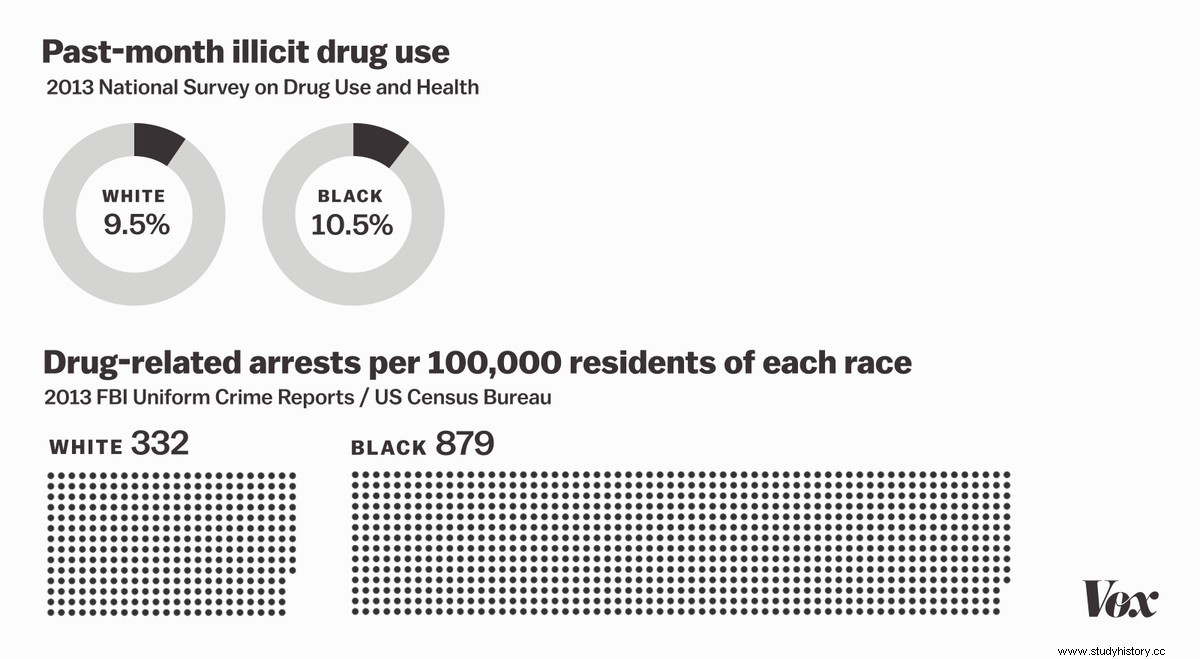When former President Richard Nixon declared a war on drugs in 1971 the damage that this so-called war would produce was unique. The war was originally proclaimed, as perceived by the ruling government at the time, as a last resort to stop the growing 'drug epidemic' in the United States. Although this war on drugs was intended to control the use of illicit drugs in the United States, the results were terrible. Not only did this war contribute to the already existing racial and class discrimination in America, it also took a toll on other countries, as violence increased among the countries that produced these banned substances.
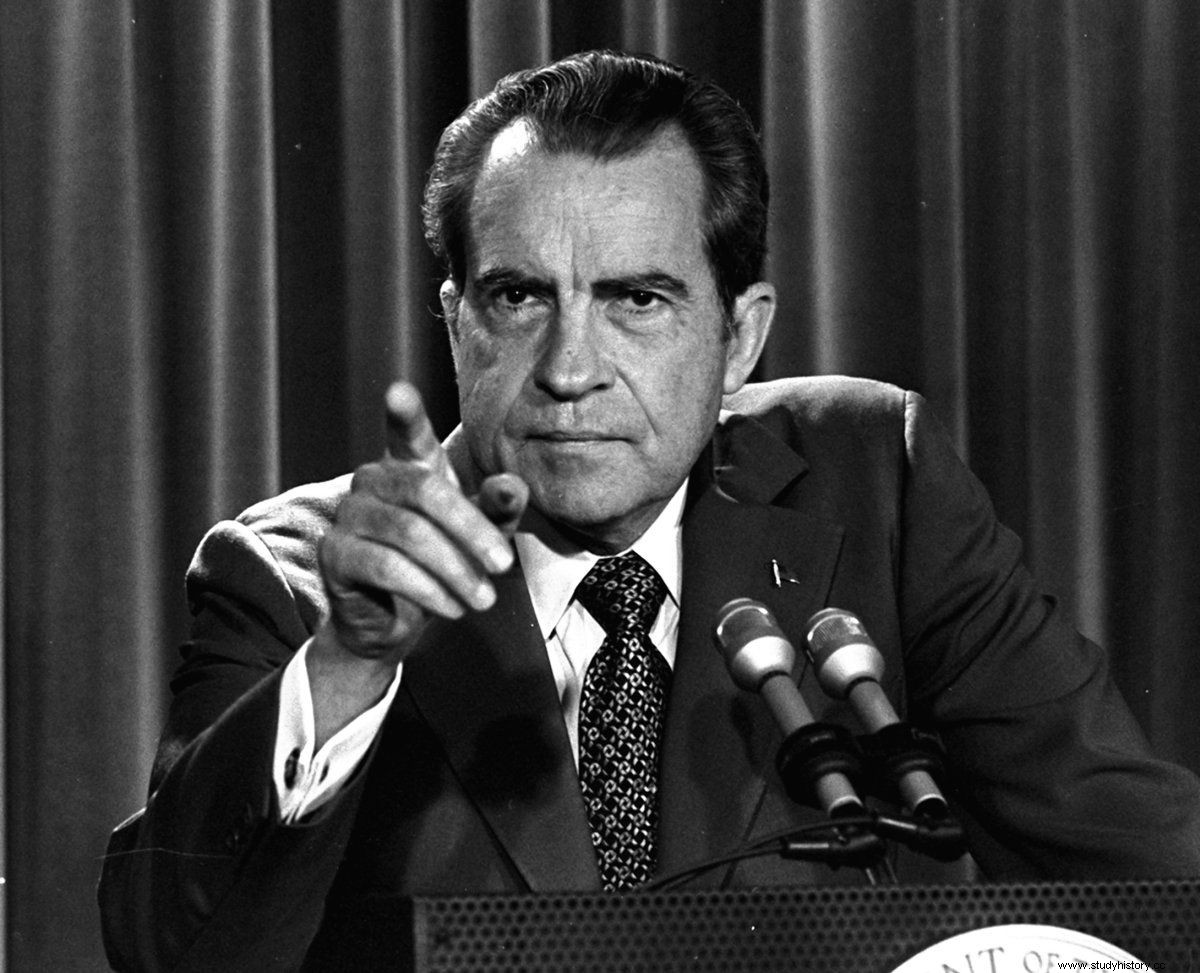
It is difficult to ignore the catastrophic events that have taken place as a result of this anti-drug war, as the effects are still felt today by all kinds of minorities. This topic is something that should continue to be highlighted, since we only know about seeing the consequences of a war announced more than 40 years ago.
America's prevailing anti-drug agenda
The United States has always had an agenda as a targeted ban on drugs, such as marijuana, cocaine and opium. There has been a lengthy process of enforcing drug laws. This rhetoric against drugs has been highlighted since the end of the 19th century.
The first legislation to trigger this drug against drugs was passed in San Francisco in 1875, which banned the smoking of opium. This legislation was passed at about the same time as an influx of Chinese immigrants appeared in California as a result of the Gold Rush. It should be noted that during that period, the cultural stereotype that Chinese men were known to smoke opium was prominent, and apparently caused it to be banned.
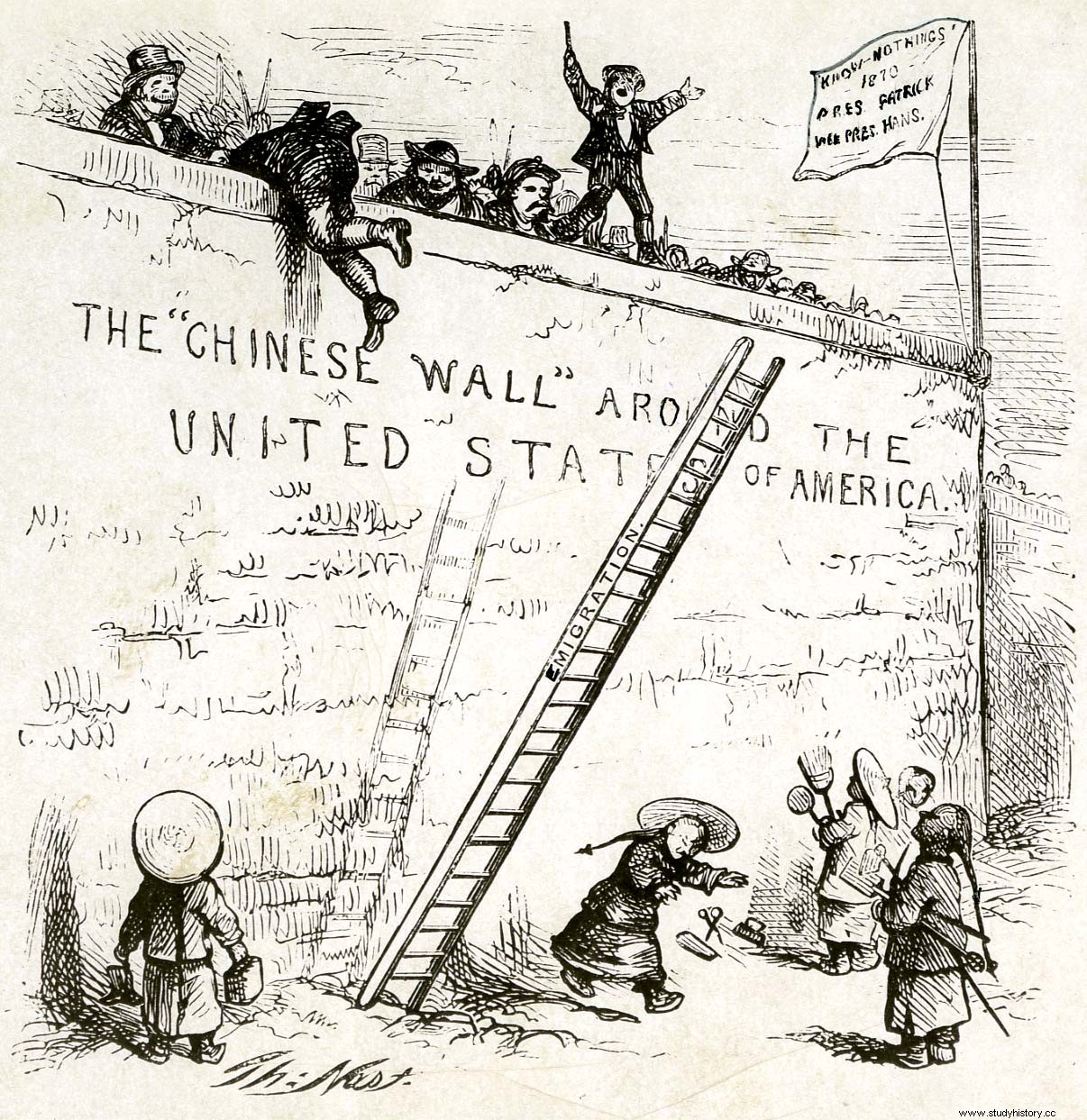
This opium law was just the springboard for what would become the first federal law in the United States against opium smoking, which was introduced in 1909, also known as the Anti-Opium Act .
The ban on opium smoking was just the beginning of what would be a sustained effort to curb drug use. Cannabis would soon join opium, as it was demonized by members of the federal government, especially Harry Anslinger, the man who would be responsible for the declaration on the war on drugs.
Harry Anslinger:Leader of the drug war
Harry Anslinger can only be described as a man who appealed to those who were full of hatred against minorities, mainly a spokesman for those known as white supremacists. Ansler's deep-rooted racism was a catalyst for what would eventually become known as the war on drugs.
Anslinger is no stranger to racist discourse. He was known for spreading racist lies about cannabis use. His motivation for this was the imminent loss of the position of commissioner of the US Treasury Department's Federal Bureau of Narcotics near the end of the Prohibition period. Ansler's focus shifted to drugs, such as heroin and cocaine, to cannabis, as he noticed increased use of cannabis among minorities. His campaign for cannabis legislation was then launched.

Anslinger provoked public outcry among white communities against cannabis by changing its name to marijuana during the campaign, associating it with anti-Mexican discrimination. Although Mexican society was not his only goal. He went on to separate the black community, as well as various other minorities. Ansling caused fear among white people by saying that:
There are 100,000 total marijuana smokers in the United States, and most are Negroes, Hispanics, Filipinos, and entertainers. Their satanic music, jazz and swing, is due to the use of marijuana. This marijuana causes white women to seek sexual intercourse with Negroes, entertainers and others.
Anslinger's obvious racism was able to entice white Americans, as America was already suffering from centuries of entrenched racism. The 1930s were no exception, as segregation and the Jim Crow Act were still prominent at the time. If anything, he was able to drive the motives of white supremacists with the notion that members of the white community would be harmed if cannabis was not banned.
Ansling's campaign against marijuana was influential, as he was able to pass federal legislation known as the Marijuana Tax Act in 1937. This made marijuana by force illegal throughout the United States. Not only would this law obviously prosecute minorities, but it would also allow racism and classicism to increase in the United States.
Boggs Act of 1951
The Boggs Act of 1951 would be one of the most outrageous legislation passed by the federal government. By placing marijuana and drugs together, this legislation would require punishment among those found to be using drugs illegally. Mandatory minimum rules will now be introduced for drug crimes, starting with a minimum of 2 to 5 years for the first offense. This legislation will only increase the police for drug use further, with legislation such as the Controlled Substances Act being passed on later.
The War on Drugs:What Really Happened
Although the Nixon presidency introduced the establishment of the Drug Enforcement Administration, it was not until Ronald Reagan became president in 1981 that drug campaigns would intensify. President Reagan wanted to pass legislation that would intensify the already outrageous police mastery of drugs.
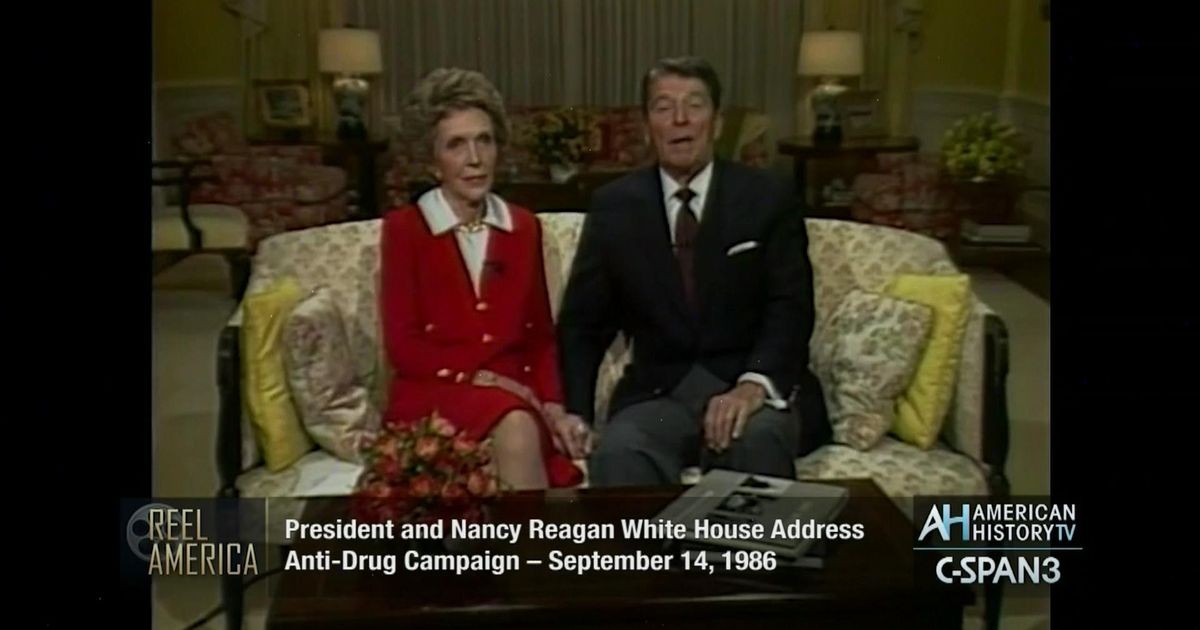
1986:Anti-Drug Abuse Act
Perhaps one of the most controversial but important laws enacted during the Reagan presidency was the Drug Abuse Act. This would be the legislation that would actually strengthen the federal government's efforts against controlled substances. This action consisted of many parts:
- Mandatory Minimum Penalties:Although the Bogg Act of 1951 established the first mandatory minimum requirements for illicit drug use, this legislation was repealed by the Drug Abuse Prevention and Control Act of 1970. The Reagan Presidency revived this law, but added many more restrictions:
Congress reintroduced mandatory prison sentences by defining the quantities of various drugs that it thought would be in the hands of drug lords, or high-level dealers. These amounts include 1,000 grams of heroin or 5,000 grams of powdered cocaine. Offenders who, with the intent to distribute, these "kingpin" amounts are subject to at least ten years in prison. Offenders who have smaller amounts that would normally be in the possession of "mid-level dealers" - such as 100 grams of heroin or 500 grams of powdered cocaine - face a sentence of at least five years.
(Brun, 2021)
- Money laundering:This action will bring laws that will criminalize the act of moving money illegally in / out of bank accounts. Drug cartels were thought to be money laundering, and by criminalizing it, drug sales would decrease.
- Differences between powdered cocaine and crack cocaine:The federal government tried to justify its stricter sentences for crack cocaine by saying:
For crack cocaine, Congress went from the "kingpin" and "mid-level dealer" categories and simply divided the amounts needed for powder cocaine sentences by 100. Thus, instead of 5,000 grams of powder cocaine, 50 grams of crack deserves a ten-year minimum sentence, and 5 grams of crack, instead of 500 grams of powder, triggers a five-year sentence. Trading in 50 grams of cocaine powder does not entail a mandatory sentence.
Congress justified this difference between 100 and 1 sentencing by emphasizing the serious social damage associated with the use of cracks. Although crack and powder cocaine are the same chemical, crack sells cheaper on the street and can be smoked, giving a shorter, more intense intoxication effect.
(Brun, 2021)
This differentiation was a crucial event in the campaign against drugs. Crack had been rogue as a drug used mainly by color communities, with a particular focus on the black community in the United States. It was depicted that the effects included predators and gang-related behavior. Police wanted to focus on low-income communities, where people of color were already facing disproportionate conditions. Arrests and imprisonments will increase drastically among these communities as a result.
Bare si nei
The Reagan presidency would also bring the America's Just Say No "campaign, started by then-first Nancy Reagan, to discourage children from participating in drug use. This campaign was run in schools across the country, where students made it a commitment to resist drug use. Although this campaign aimed to reduce the use of illicit drugs by making them rash, it failed to warn children that prescription drugs can be just as addictive, if not worse in some cases.
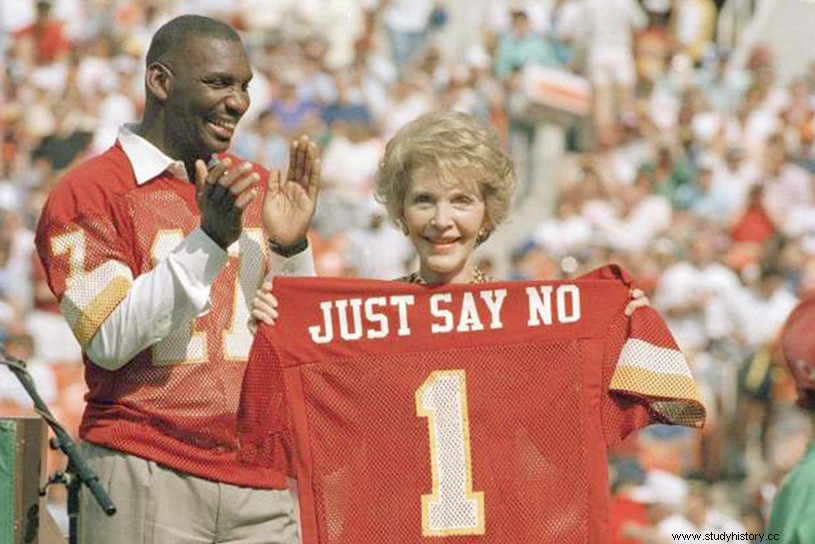
The problematic persecution of drugs
It has long been a story that drugs in themselves are bad and should be banned as a safe way to discourage drug use. Although the drug war was initialized as an attempt to fight the growing drug epidemic, the fight ended up harming its own citizens as well as other countries.
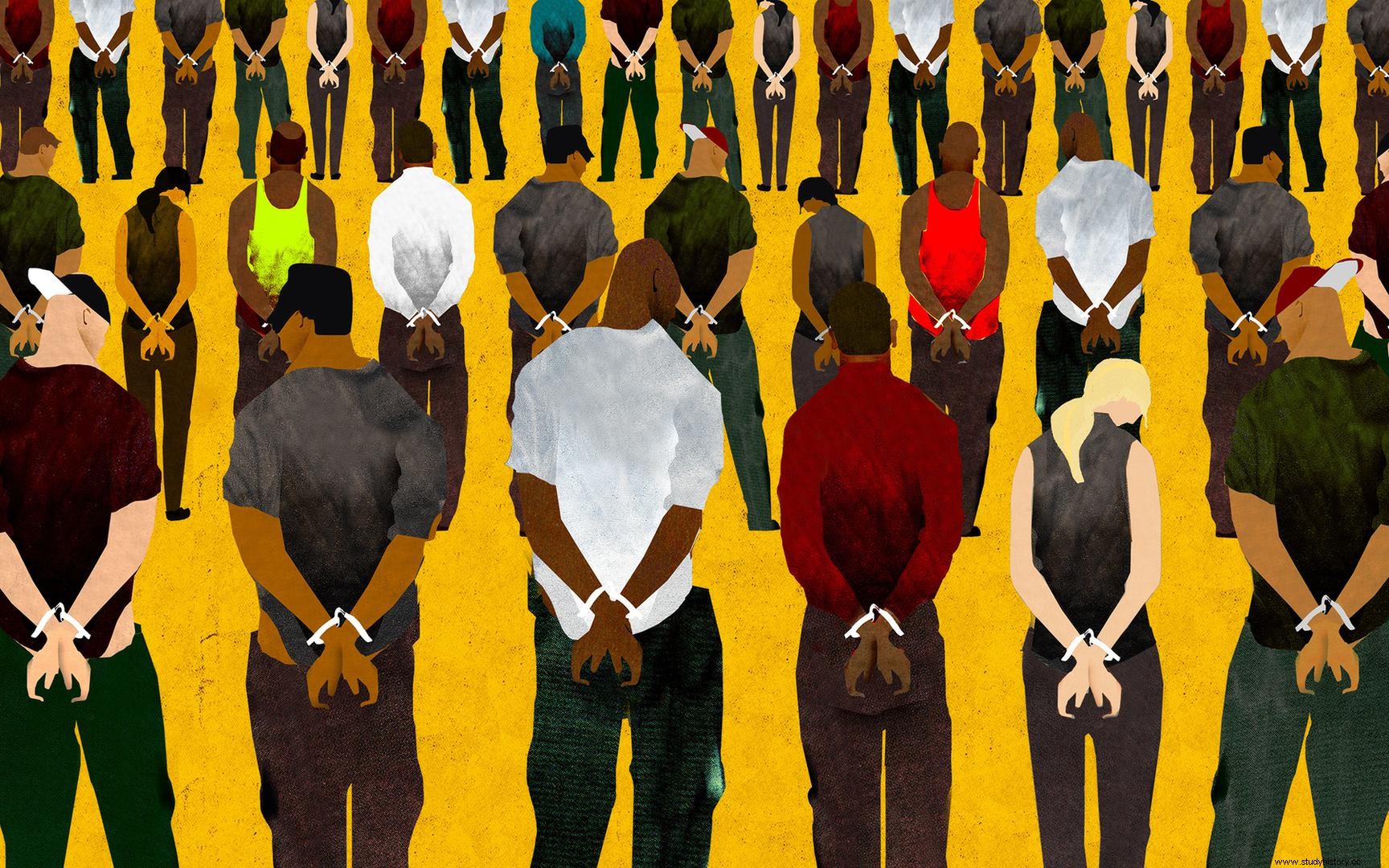
Criminalization of people with color
The war on drugs will continue to increase discrimination among people of color. Drug laws were externally put in place to further systematically suppress colored communities, which had already faced other systemic problems.
Racial targeting increased among law enforcement, which led to the rate of imprisonment among black men, as well as other colored people, accelerating rapidly. By criminalizing drug possession, colored people were drastically influenced, as racist rhetoric involving colored communities and drug use was a key factor in why the campaign against drugs was as successful as it was.
Mass imprisonment has placed inequality in the criminal justice system, the very system that should fight against injustice. Betsy Pearl, Assistant Director of Criminal Justice Reform at American Progress, states that:
Colored persons make up 70 per cent of all defendants convicted of prosecution with a mandatory minimum sentence. Prosecutors are twice as likely to prosecute a mandatory minimum sentence for a black defendant than a white defendant charged with the same offense, 16 and black defendants are less likely to receive relief from the mandatory minimum. 17 On average, defendants who are subject to mandatory use a minimum of five times longer imprisonment than those convicted of other offenses. 18
(2018)
Discriminated societies with colored faces are inevitable when they are constantly monitored for criminal activity. The war on drugs can be seen as an excuse to hide a racist agenda.
How the war on drugs failed to help widespread addiction
The US government failed to consider all possible outcomes that would arise as a side effect of their campaign against drugs. The fact is that drug bans lead to disease and, in the worst case, overdoses. By banning drugs, people will simply find more illegal ways to obtain drugs, which often tend to be unclean. The opioid crisis that has taken place in recent years is a devastating example of this.
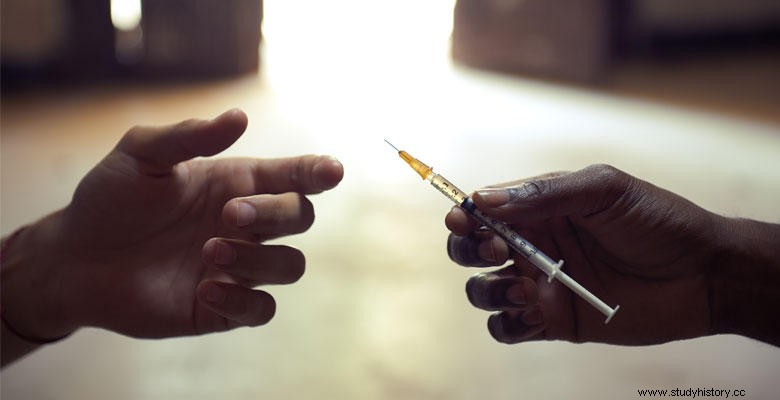
Prohibition promotes unsafe drug use among citizens. While there is no guaranteed safe way to use drugs, legalization helps reduce the serious risks associated with illicit drugs. During drug criminalization, serious problems arise:
First, users are likely to switch from lower strength to higher strength for a given type of drug (for example, from marijuana with lower to higher concentrations of THC). Second, users can switch from low-potency drugs to harder drugs (such as from marijuana to cocaine). Third, users are likely to use methods of ingestion that increase the effectiveness of drugs (such as injecting instead of smoking a drug). Taken together, these information and potency effects mean that bans are likely to increase drug overdoses ... higher prices encourage more intense uses, such as injection. Law enforcement's desire to promote bans generates restrictions on legal needles and syringes. In many states it is illegal to buy and sell needles and syringes without a prescription. These two effects are combined to encourage the reuse and sharing of dirty needles. (Repeated use of needles even by the same individual is unsafe. Needles dull with each use and can break off under the skin, thus causing infections or other problems.) Sharing needles drastically increases the risk of transmitting blood-borne diseases such as. HIV / AIDS and hepatitis.
(Coyne and Hall, 2017)
While mandatory minimum penalties were introduced in the effort to stop drug use, this is usually not the case. Those who are imprisoned for possession of drugs are at greater risk of overdose, once released from prison. Research shows that:
Capturing people for drug-related offenses has been shown to have little impact on drug use rates. 5 Instead, imprisonment is linked to increased mortality after overdose. During the first two weeks after release from prison, individuals are almost 13 times more likely to die than the general population. 6 The leading cause of death among recently released individuals is overdose. 7 During this period, individuals have a 129 percent greater risk of dying from an overdose than the general public. 8
(Pearl, 2018)
It is clear that the drug war has had lasting effects in the United States that have caused more harm than good. While they persecute the citizens themselves for drug use, the government and the criminal justice system have failed to help those suffering from addiction. This could have been prevented if more money had been invested in rehabilitation and addiction prevention programs, which are not available to them in low-income areas. To learn more about why the war on drugs failed, visit this link.
What was the ultimate goal of the war on drugs?
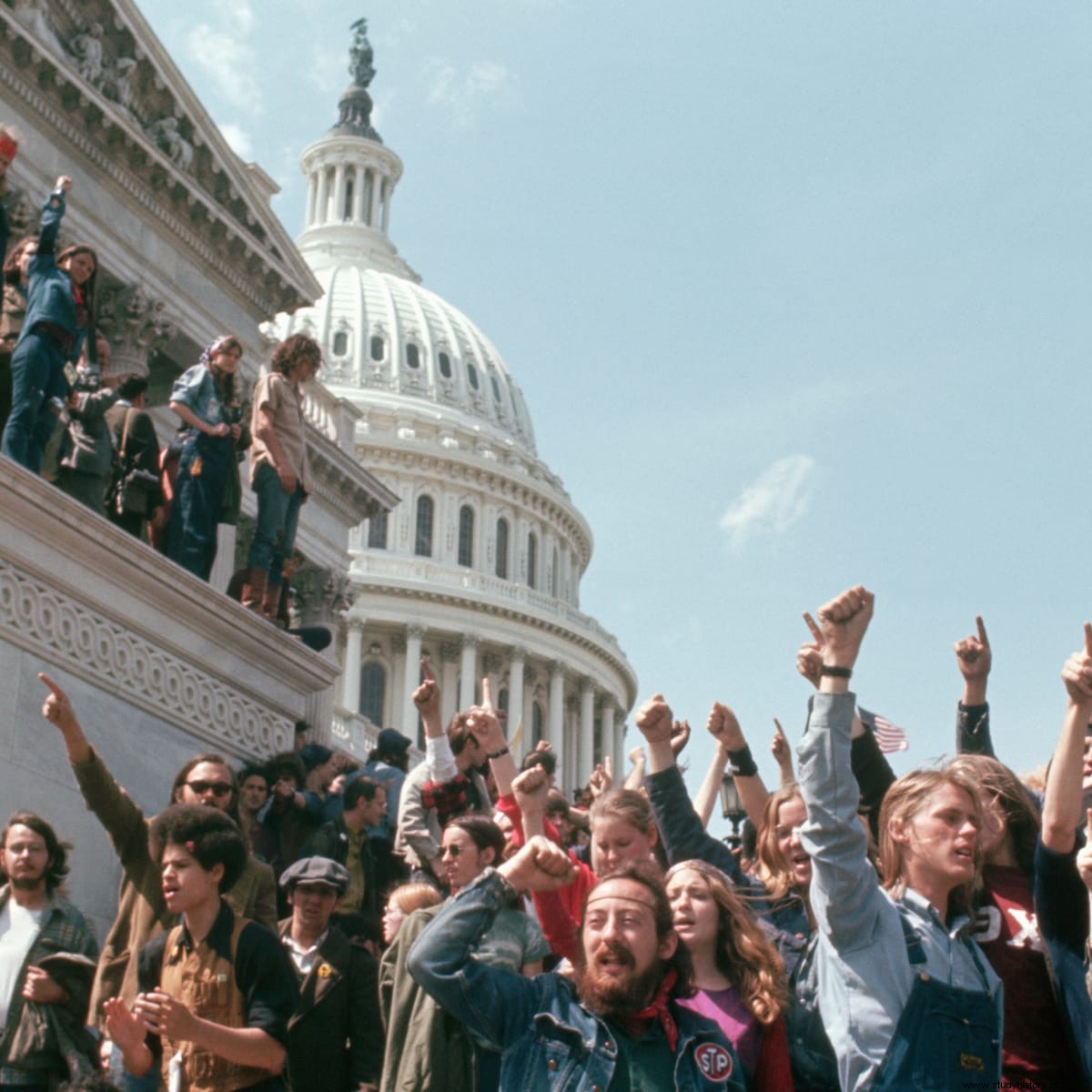
As we reflect on the war on drugs, the cultural norms that were valued in the 1970s must be emphasized. The decade before introduced the hippie movement, as well as the continuation of the Vietnam War. The US government faced a huge dilemma, with pressure from some citizens to do something about this so-called radicalization among the younger generation.
Hippiebevegelsen
The hippies were part of a counterculture that entered America in the late 60's, which can clearly be correlated with the Vietnam War. This movement was perfect for those who were tired of the everyday reality of everyday life. Being a hippie was a kind of protest against how the country was run, mainly consisting of the white middle class. The young people were focused on advocating for peace, love and equality, with priorities that belonged to issues such as women's rights, segregation and capitalism.
Love Summer
1967 brought the Summer of Love, one of the most significant phenomena in counterculture in the United States. The Haight-Ashbury area of San Francisco, California would be a place for hippies to participate in:
free sex, drugs and a lot of rock 'n' roll - the more thought-provoking and psychedelic the better - [and] pursued an idealistic utopian vision of world peace, love and anti-materialism.
It was a time when youthful rebellion was in the air, be it against the war in Vietnam, racism, the political status quo and a button-down, 9 to 5 world of "Mad Men" -like conformity.
(Varga, 2017)
Hippies would be seen as a ticking time bomb for older generations, as they became angry at the resistance this society had built in accordance with the authorities. It was unheard of at this time to see such a revolt among the youth. The next generation was considered to promote taboo things, especially since they were so open to talk about sex and psychedelics and cause:
an attempt to curb the movement, the authorities banned the psychedelic drug LSD, restricted political gatherings and tried to enforce bans on what they considered obscenity in books, music, theater and other media.
(Lumen)
When young people became so resilient to the government's agenda, officials had no choice but to do something about it. It would be demanding for the government to run otherwise, with so many citizens against what the government did, especially with the horrific Vietnam War. The Nixon administration's domestic policy chief, John Ehrlichman, admitted in 1994 that:
The 1968 Nixon campaign, and the Nixon White House after it, had two enemies:the anti-war left and black people. Do you understand what I'm saying? We knew we could not make it illegal to be either against the war or black, but by getting the public to associate the hippies with marijuana and blacks with heroin, and then criminalize both heavily, we could disrupt these communities. We could arrest their leaders, loot their homes, break up their meetings, and make them out night after night on the evening news.
The government was heavily criticized, using the drug war as a last resort to control the coming uprising they began to see. Without the war on drugs, the government would either be magnified for their inability to start an overthrow with the youth, or its inability to put in place policies and legislation that would make the country more equal for all citizens, not just the most privileged. <. / P> 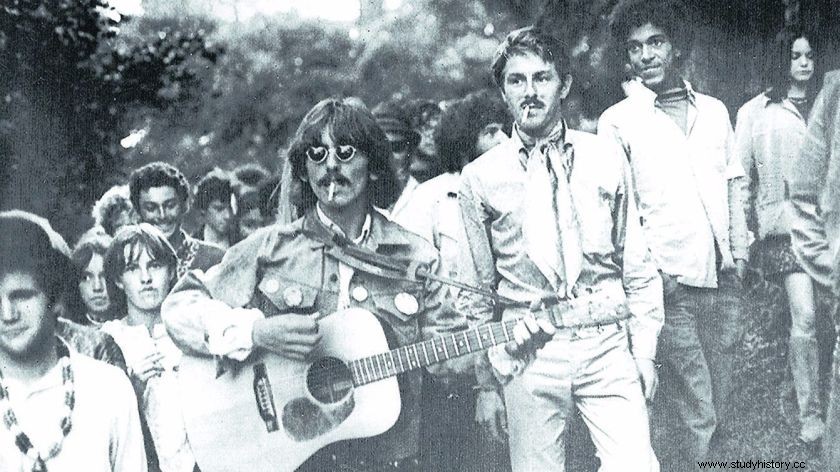
TØR:Education against drug abuse
DARE was introduced to primary schools around America in 1983 and was an attempt to inform young children about the dangers of drugs. Although the intentions of the program were well-versed, the implementation was less than successful. The effects of the DARE program were almost invisible, proving that:
DARE was (and is) completely ineffective in preventing drug use. The numbers that demonstrated this began to roll back in 1992, when a study conducted at Indiana University showed that candidates from the DARE program later had a significantly higher proportion of hallucinogenic drugs than those who were not exposed to the program.
(Wolchover, 2012)
DARE would eventually lose federal funding, apparently as the government realized that their efforts to prevent the drug epidemic had failed. Not much could be done without funding for affordable rehabilitation facilities for those struggling with addiction. The government is working to prioritize rehabilitation services, with states making an effort to make rehabilitation free. But until the entire health care system is reformed, rehabilitation will still be unavailable to those who are struggling financially.
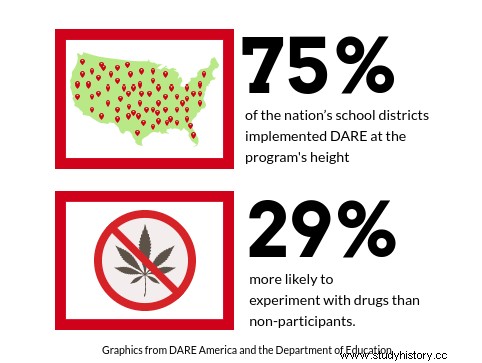
Anthropological significance
The war on drugs was not as successful as it had hoped when it was introduced, and they were criminalized for possession of recreational drugs. Although it may have failed, it has allowed us to find methods that are still most successful in reducing overdoses. Furthermore, other countries also have difficulties with similar conditions.
With the opening of centers where those who want to participate in drug use can do so without worrying about the transmission of diseases and potential overdose, drug use can take place in a safe way without being rogue. Drugs will continue to be stigmatized, as many still believe it is morally wrong. Nevertheless, the legalization of marijuana in some states allows more acceptance among the citizens.
